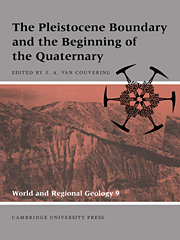Book contents
- Frontmatter
- Contents
- List of contributors
- Preface: the new Pleistocene
- Foreword
- Part I Definition of the base of the Quaternary
- Part II Characterization of the Pleistocene boundary-stratotype
- Part III The paleontological context of the Pleistocene boundary
- Part IV The Pleistocene boundary in regional sequences
- 11 The Pliocene–Pleistocene boundary in Italy
- 12 Stratigraphy of the Plio–Pleistocene sequence of the Mediterranean coastal belt of Israel and its implications for the evolution of the Nile Cone
- 13 The Pliocene–Pleistocene transition in the Iberian Peninsula
- 14 Biostratigraphy and calibrated climatic chronology of the Upper Pliocene and Lower Pleistocene of France
- 15 The Plio–Pleistocene of England and Iceland
- 16 The Neogene–Ouaternary boundary in The Netherlands
- 17 The Tertiary–Quaternary boundary in western Germany
- 18 The Pliocene–Pleistocene boundary in eastern Germany
- 19 The Plio–Pleistocene of Hungary
- 20 The Pliocene–Pleistocene boundary in Romania
- 21 The Pliocene and Pleistocene of the European part of the Commonwealth of Independent States
- 22 The N/Q boundary in Asian Russia and Tadjikistan
- 23 The Pliocene–Pleistocene boundary in the Indian subcontinent
- 24 The Pliocene–Pleistocene boundary in Japan: the Osaka Group, Kinki district
- 25 The Pliocene–Pleistocene boundary in Japan: stratigraphy in the Boso Peninsula, central Japan
- 26 The base of the Quaternary in China
- 27 Plio–Pleistocene deposits and the Quaternary boundary in sub-Saharan Africa
- 28 Plio–Pleistocene reference sections in Indonesia
- 29 The Pliocene–Pleistocene boundary in New Zealand
- 30 The Pliocene–Pleistocene boundary in continental sequences of North America
- Index
12 - Stratigraphy of the Plio–Pleistocene sequence of the Mediterranean coastal belt of Israel and its implications for the evolution of the Nile Cone
Published online by Cambridge University Press: 10 November 2009
- Frontmatter
- Contents
- List of contributors
- Preface: the new Pleistocene
- Foreword
- Part I Definition of the base of the Quaternary
- Part II Characterization of the Pleistocene boundary-stratotype
- Part III The paleontological context of the Pleistocene boundary
- Part IV The Pleistocene boundary in regional sequences
- 11 The Pliocene–Pleistocene boundary in Italy
- 12 Stratigraphy of the Plio–Pleistocene sequence of the Mediterranean coastal belt of Israel and its implications for the evolution of the Nile Cone
- 13 The Pliocene–Pleistocene transition in the Iberian Peninsula
- 14 Biostratigraphy and calibrated climatic chronology of the Upper Pliocene and Lower Pleistocene of France
- 15 The Plio–Pleistocene of England and Iceland
- 16 The Neogene–Ouaternary boundary in The Netherlands
- 17 The Tertiary–Quaternary boundary in western Germany
- 18 The Pliocene–Pleistocene boundary in eastern Germany
- 19 The Plio–Pleistocene of Hungary
- 20 The Pliocene–Pleistocene boundary in Romania
- 21 The Pliocene and Pleistocene of the European part of the Commonwealth of Independent States
- 22 The N/Q boundary in Asian Russia and Tadjikistan
- 23 The Pliocene–Pleistocene boundary in the Indian subcontinent
- 24 The Pliocene–Pleistocene boundary in Japan: the Osaka Group, Kinki district
- 25 The Pliocene–Pleistocene boundary in Japan: stratigraphy in the Boso Peninsula, central Japan
- 26 The base of the Quaternary in China
- 27 Plio–Pleistocene deposits and the Quaternary boundary in sub-Saharan Africa
- 28 Plio–Pleistocene reference sections in Indonesia
- 29 The Pliocene–Pleistocene boundary in New Zealand
- 30 The Pliocene–Pleistocene boundary in continental sequences of North America
- Index
Summary
Introduction
The Plio–Pleistocene sedimentary sequence of the coastal plain and the continental shelf of Israel is an integral part of the Nile Cone, which has been building up since the end of the Messinian Event. The Yafo Formation of the Saqiye Group (Pliocene to early Pleistocene) and the Hefer Formation of the Kurkar Group (Pleistocene), which constitute this sequence, are subdivided into 15 correlatable members. Nine biostratigraphic datum levels have been established within the sequence, which permits correlations to the Plio–Pleistocene events in the central Mediterranean and Italian sequences.
Background
Our compilation of the marine Plio–Pleistocene sequence of the coastal belt of Israel is based mostly on our previous studies and on additional examinations of new boreholes. The lithostratigraphy and mapping, including correlations of wells and outcrops, interpretations of seismic surveys, subcrop mapping, and sedimentology, were published by Gvirtzman (1969a,b, 1970, 1983) and Gvirtzman and Buchbinder (1969). Other publications include studies of biostratigraphy and molluscan correlation by Moshkovitz (1961, 1963, 1968), studies of nannofossil biostratigraphy by Ehrlich and Moshkovitz (Ehrlich and Moshkovitz, 1978; Moshkovitz and Ehrlich, 1980), studies of foraminiferal biostratigraphy by Martinotti (1981a–c, 1986), and studies of combined biostratigraphy of foraminifera and nannofossils by Moshkovitz and Martinotti (1979). In addition, compilations and regional syntheses were prepared by Gvirtzman and Buchbinder (1977, 1978) and by Gvirtzman et al. (1984).
The Nile Cone
The Plio–Pleistocene sequence is an integral part of the Nile Cone (Figure 12.1). The eastern lobe of the cone is formed by sediments which are transported by the Nile River and are carried by anticlockwise longshore currents into the southeastern corner of the Mediterranean (Emery and Bentor, 1960; Emery and Neev, 1960; Neev et al., 1976; Nir, 1984).
- Type
- Chapter
- Information
- The Pleistocene Boundary and the Beginning of the Quaternary , pp. 156 - 168Publisher: Cambridge University PressPrint publication year: 1996
- 1
- Cited by



